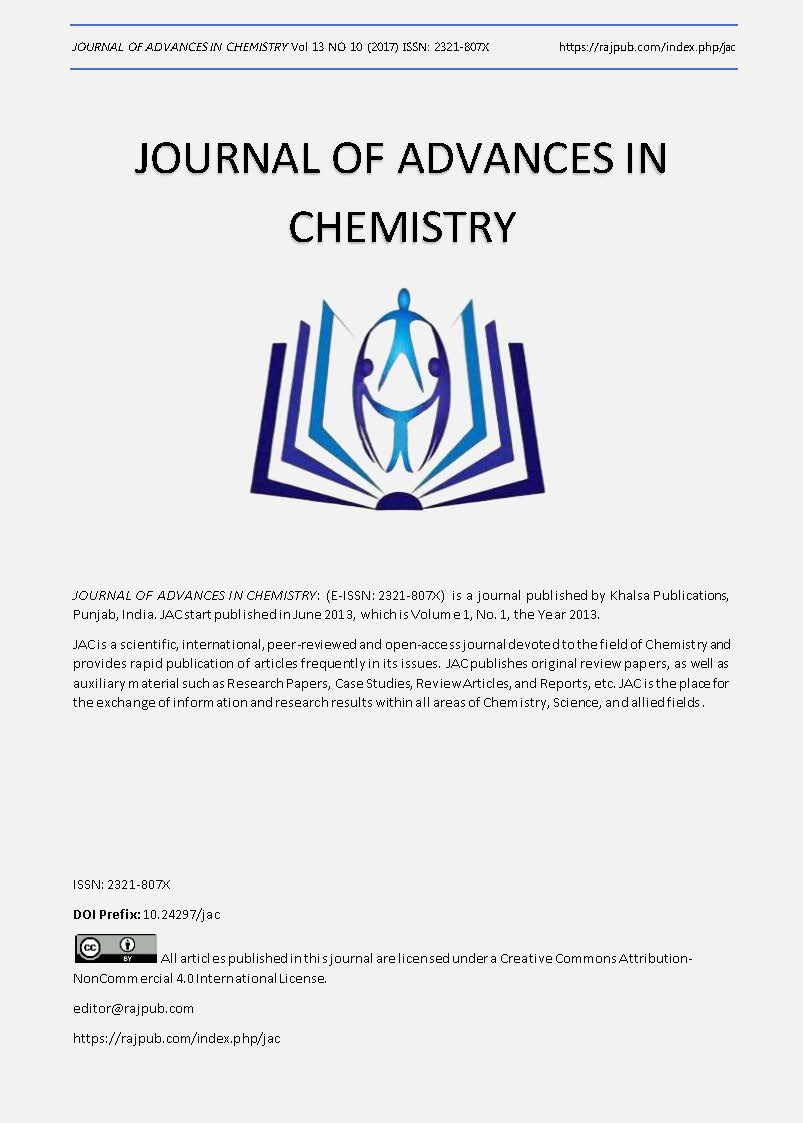ACID GAS ABSORPTION STUDIES IN PACKED COLUMN
DOI:
https://doi.org/10.24297/jac.v13i10.5789Keywords:
carbon dioxide absorption, DEA, chemical absorption, MEA, AmmoniaAbstract
Carbon dioxide is a major greenhouse gas that results in climatic changes. Reducing CO2 emission for addressing the climatic change concerns is becoming increasingly important as the CO2 concentration in the atmosphere has increased rapidly since the industrial revolution. Many mitigation methods, including CO2 sequestration and novel CO2 utilization, are currently under investigation. Most of these processes require CO2 in a concentrated form. However the CO2 from large sources such as fossil fueled power plants is mixed with nitrogen, water vapor, oxygen and other impurities. The current commercial operations for capturing CO2 from flue gas use a chemical absorption method with Monoethanol Amine (MEA) as the sorbent. The method is expensive and energy intensive. The cost of capturing a ton of CO2 including removing impurities and compressing CO2 to supercritical pressure using existing MEA technology would be very high, and the power output would be significantly reduced by the energy consumption in capturing and compressing CO2. In this work alternative solvent ammonia, is used which can overcome the disadvantages of current technology using amines such as MEA and DEA.
Downloads
References
2. Abu-Zahra, M., Schneiders, L. Niederer, J. Feron, P. Versteeg (2007) ’CO2 capture from power plants’ Part I ‘A parametric study of the technical performance based on Monoethanolamine’, Int J GHG Cont, Chapter 1 (1), pp. 37-46.
3. Ali.S.H, Merchant, S.Q. and Fahim.M.A (2002) ’Reaction kinetics of some secondary alkanolamines with carbon dioxide in aqueous solutions by stopped flow technique’. Sep Purif Technol, vol: 27; pp. 121–136.
4. Coulson, J.M. and J.F. Richardson (1991)’Chemical Engineering, 4th ed, Butterworth Heinemann, Oxford, Vol.2.
5. Franchi RS, Harlick PJE, Sayari A. (2004) ‘Applications of pore-expanded mesoporous silica. 2. Development of a high-capacity, water-tolerant adsorbent for CO2’, Ind Eng Chem Res, vol: 44, 8007–13.
6. Gabrielsen, J., et al, (2007) ‘Experimental validation of a rate-based model for CO2 capture using an AMP solution’, Chem Eng Sci, vol: 62, pp. 2397–2413.
7. Hamid Reza Godini, Dariush Mowla, (2008)’Selectivity study of H2S and CO2 absorption from gaseous mixtures by MEA in packed beds’, Chem Eng Research and Design, vol:86, pp.401-409.
8. Hendy Thee and Yohanes, (2012) ‘A kinetic and process modeling study of CO2 capture with MEA-promoted potassium carbonate solutions’, Chem Eng Sci, Vol:210, pp: 271-279.
9. J. Wallace, S. Krumdieck, (2005) ‘Carbon dioxide scrubbing from air with amine solution in a packed bubble column’, J. Mech. Eng. Sci, vol: 219, pp.1225–1233
10. J.T. Yeh, H.W. Pennline, (2001), ‘Study of CO2 absorption and desorption in a packed column’, Energy Fuels,278 vol: 15, pp. 274.
11. Jimmy Xiao, Chih-Wei Li and Meng-Hui Li, (2000) ’Kinetics of absorption of carbon dioxide into aqueous solutions of 2-amino-2-methyl-1-propanol+monoethanolamine’, Chem Eng Sci, vol:161, pp. 161-175.
12. Kim S, Ida J, Guliants VV, Lin JYS,(2005) ’Tailoring pore properties of MCM-48 silica for selective adsorption of CO2’.J Phys Chem B, vol: 109, 6287–93.
13. Krishnamurthy.R, Taylor; (2008) ’Simulation of packed distillation and absorption columns’, Industrial and Engineering Chemistry Process Design and Development, 24 (3), pp. 513–524.
14. Kvamsdal, H.M.Jakobsen, J.P.Hoff, (2009) ‘Dynamic modeling and simulation of a CO2 absorber column for post-combustion CO2 capture’, Chemical Engineering and Processing 48(1), pp. 135–144.
15. L.S. Tan, A.M. Shariff, K.K. Lau and M.A. Bustam, (2012) ‘Factors affecting CO2 absorption efficiency in packed column: A review’, Journal of Industrial and Eng Chemistry, Vol:18, pp.1874-1883.
16. Levinspiel, O. (1972),’Chemical reaction engineering’, 2nd ed. John Wiley and Sons, Inc, pp.210-213, 320-326.
17. Luyben, W.L. (1989) ‘Process modelling, simulation, and control for chemical engineers’, 2nd ed. McGraw-Hill, pp. 22-24.
18. Mandal, B.P. and Bandyopadhyay, S.S (2005) ‘Simultaneous absorption of carbon dioxide and hydrogen sulfide into aqueous blends of 2-amino-2-methyl-1-propanol and diethanolamine’. Chem Eng Sci, vol: 60, pp. 6438–6451.
19. Mani, F., Peruzzini, M. & Stoppioni. P, (2006)’CO2 absorption by aqueous NH3 solutions: speciation of ammonium carbamate, bicarbonate and carbonate by a 13C NMR study’ Green Chemistry, 8, pp. 6-18.
20. MartÃnez.I, Romano. M. C, Fernández. J. R, Chiesa. P, Murillo. R, Abanades. J.C. (2013), ‘Process design of a hydrogen production plant from natural gas with CO2 capyure based on a novel Ca/Cu chemical loop’, science direct,vol: 114, pp. 192–208.
21. Notz R, Asprion N, Clausen I, Hasse H (2007),’Selection and Pilot Plant Tests of New Absorbents for Post Combustion Carbon Dioxide Capture’, Chemical Engineering Research and Design, vol: 85, pp.510-5.
22. O.J. Curnow, S.P. Krumdieck, E.M. Jenkins, (2005) ‘Regeneration of carbon dioxide saturated monoethanolamine-glycol aqueous solutions at atmospheric pressure in a packed bubble reactor’, Ind. Eng. Chem. Res, vol: 44, pp. 1085–1089.
23. Pant K.K. and Srivastava, V.K, (2007),‘Carbon dioxide absorption into monoethanolamine in a continuous film contactor’, Chem Eng J, vol: 133, pp. 229– 237.
24. Perry, R.H. Green.D.W, (1984) ’Perry’s Chemical Engineers’ Handbook, 6th ed., McGrawHill, Chapter 14, pp.38-56.
25. Puxty, G., R. Rowland, and M. Attalla (2010),’Comparison of the rate of CO2 absorption into aqueous ammonia and monoethanolamine’, Chemical Engineering Science 65(2), pp. 8.
26. Qi G, Wang Y, Estevez L, Duan X, Anako N, Park AA, et al.(2011) ‘High efficiency nanocomposite sorbents for CO2 capture based on amine-functionalized mesoporous capsules’, Energy Environ Sci,vol:4, pp.444–452.
27. R.J. Hook, (1997) ‘An investigation of some sterically hindered amines as potential carbon dioxide scrubbing compounds’, Ind. Eng. Chem. Res, vol:36, pp.1779–1790.
28. Rascol. E, Meyer.M.Hour, M.H. and Prevost.M, (1997) ‘Modeling and simulation of the absorption of H2S and CO2 into mixed alkanol amine solutions’, Hung J Ind Chem, vol: 25, pp. 11–16.
Additional Files
Published
How to Cite
Issue
Section
License
 All articles published in Journal of Advances in Linguistics are licensed under a Creative Commons Attribution 4.0 International License.
All articles published in Journal of Advances in Linguistics are licensed under a Creative Commons Attribution 4.0 International License.




